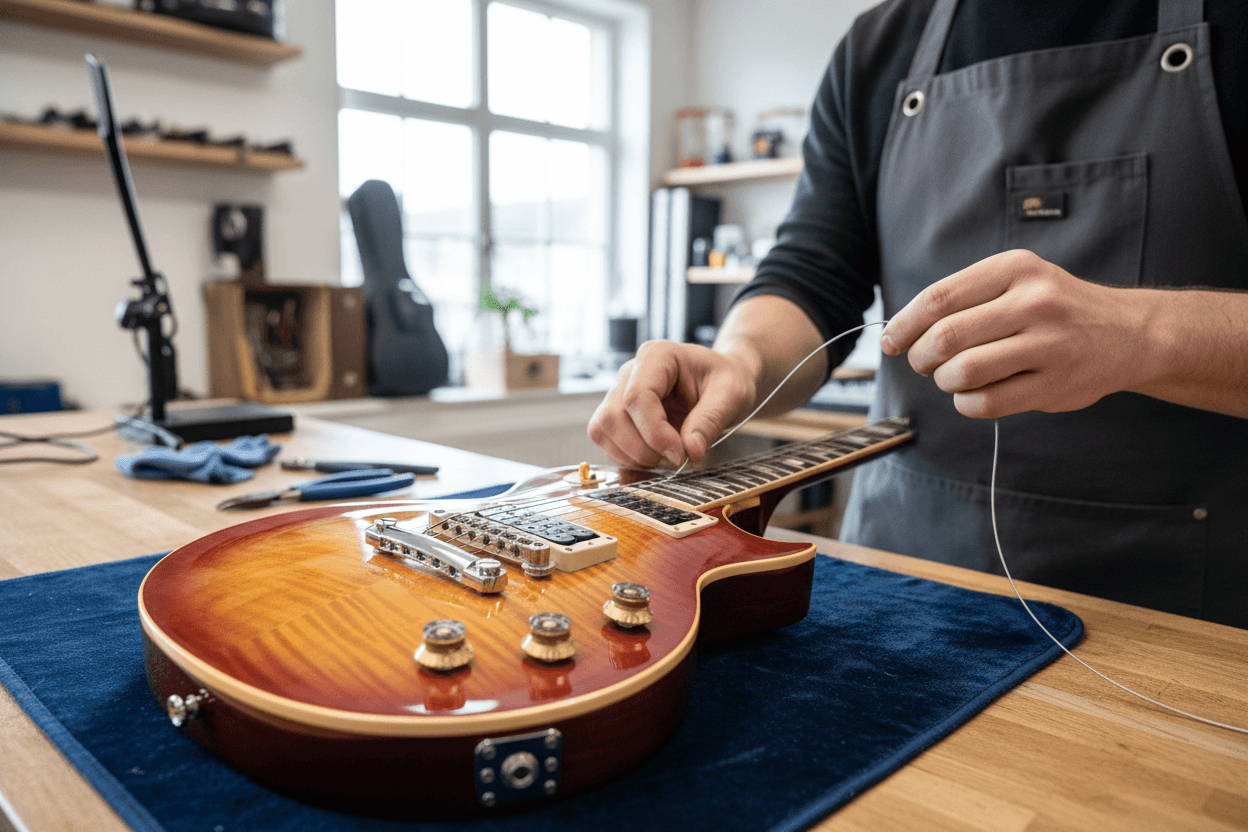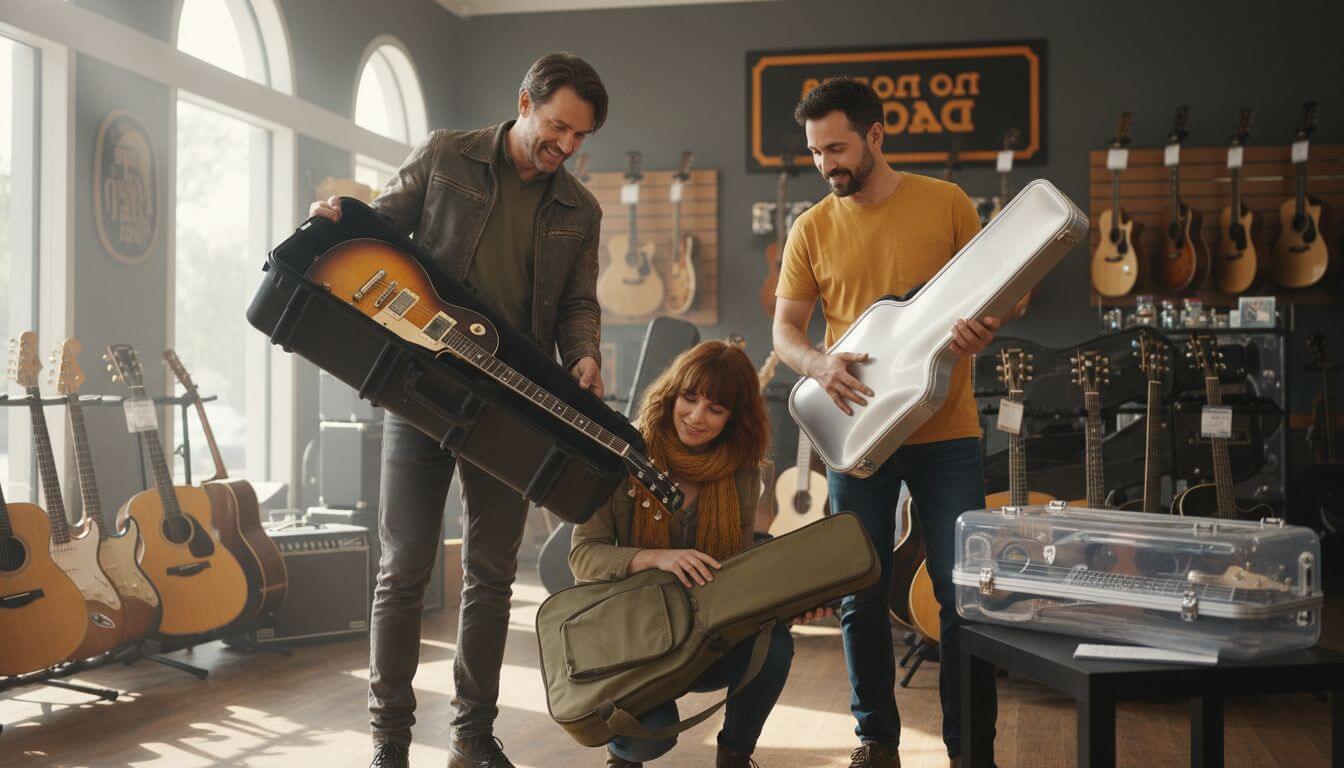Most british guitarists quickly discover that choosing the right bridge can shape not just their sound, but how often they need to retune or deal with repairs. With over 80 percent of players citing bridge type as crucial to their playing comfort and tone, understanding each design’s strengths is more than a technical detail. From effortless tuning to wild pitch bends, this guide gives you a clear look at what sets each bridge apart so you can make a confident choice.
Table of Contents
- 1. Fixed Bridges: Reliable Tuning and Easy Maintenance
- 2. Tremolo Bridges: Allowing Pitch Bends and Vibrato
- 3. Tune-O-Matic Bridges: Popular Choice For Les Pauls
- 4. Hardtail Bridges: Enhanced Stability For Rhythm Players
- 5. Floyd Rose Bridges: Ultimate Dive Bombs And Locking Tuners
- 6. Wraparound Bridges: Simple Design And Tonal Benefits
- 7. Acoustic Guitar Bridges: Unique Construction And String Mounting
Quick Summary
| Takeaway | Explanation |
|---|---|
| 1. Fixed bridges provide exceptional tuning reliability. | Their design anchors strings firmly, reducing slippage and enhancing intonation, perfect for dependable performance. |
| 2. Tremolo bridges enable expressive pitch manipulation. | These allow musicians to create vibrato and pitch bends, adding emotional depth to musical performances. |
| 3. Tune-o-matic bridges offer precise intonation control. | They feature adjustable saddles, ensuring each string rings true, ideal for discerning guitarists. |
| 4. Hardtail bridges ensure maximum stability and sustain. | By anchoring strings directly to the guitar body, they eliminate pitch fluctuations, ideal for rhythm players. |
| 5. Wraparound bridges enhance tonal transfer efficiently. | Their simple design minimizes mechanical interference, providing musicians with pure tonal qualities. |
1. Fixed Bridges: Reliable Tuning and Easy Maintenance
Fixed bridges represent the most straightforward and dependable guitar bridge design for musicians seeking stability and consistent performance. These solid metal bridges attach directly to the guitar body, providing a rock solid connection that minimises unwanted vibrations and maximises sustain.
Unlike more complex bridge systems, fixed bridges deliver exceptional tuning reliability by anchoring strings firmly in place. This design means less movement between the string and bridge, which translates to improved intonation and reduced string slippage. Players who prioritise consistent tone and minimal maintenance will find fixed bridges an excellent choice.
The mechanical simplicity of fixed bridges makes them particularly attractive for beginners and professional musicians alike. Their construction typically involves a single metal plate with individual string saddles that can be adjusted for precise string height and intonation. Key advantages include:
- Simple, robust engineering
- Minimal tuning complications
- Extremely low maintenance requirements
- Enhanced sustain and tone stability
Whether you are performing on stage or practising at home, a fixed bridge provides a reliable platform for your musical expression. They work brilliantly across multiple genres from blues and rock to jazz and folk, offering musicians a dependable foundation for their sonic explorations.
2. Tremolo Bridges: Allowing Pitch Bends and Vibrato
Tremolo bridges represent an ingenious guitar design that transforms how musicians create expressive sound modulations. Introduced by Fender in 1954, these sophisticated bridge systems enable players to dramatically alter pitch using a mechanical arm or “whammy bar”, creating vibrato and pitch bend effects that add emotional depth to musical performances.
According to Luthiery.org, the synchronized tremolo system integrates the bridge and tremolo block into a single pivoting unit. This engineering marvel allows guitarists to manipulate string tension dynamically, producing smooth pitch variations that range from subtle vibrato to dramatic dive bombs. Key features of tremolo bridges include:
- Ability to bend pitch both up and down
- Floating bridge design that moves with string pressure
- Mechanical flexibility for expressive playing techniques
Guitar Craft Academy emphasises that proper setup is critical for maintaining tuning stability while using tremolo effects. Players need to balance spring tension and fine tune the bridge to prevent unintended pitch shifts. These bridges work brilliantly across genres like rock, blues, and metal where dramatic sound manipulations are prized.
Mastering tremolo techniques requires practice and understanding of your specific bridge mechanism. Whether you are creating gentle wavering notes or aggressive pitch drops, a well configured tremolo bridge offers unparalleled musical expression.
3. Tune-O-Matic Bridges: Popular Choice for Les Pauls
The Tune-o-matic bridge represents a pinnacle of guitar engineering specifically designed to deliver exceptional intonation and playability. Most famously associated with Gibson Les Paul guitars, this bridge system has become a gold standard for musicians seeking precision and tonal clarity.
Gibson Les Paul vs. Gibson SG: Which Guitar is Right for You? explores the nuanced world of these iconic instruments, but the Tune-o-matic bridge stands out as a crucial component. According to Wikipedia, this bridge features individually adjustable saddles that allow guitarists unprecedented control over string height and intonation.
Key advantages of Tune-o-matic bridges include:
- Precise individual string intonation
- Easy height adjustment capabilities
- Enhanced sustain and tone stability
- Improved overall playing comfort
The bridge design enables players to fine tune each string independently, ensuring that notes ring true across the entire fretboard. This level of precision makes the Tune-o-matic particularly beloved among rock, blues, and jazz musicians who demand consistent sound quality. Whether you are performing on stage or recording in a studio, this bridge offers the reliability and tonal clarity that discerning guitarists require.
4. Hardtail Bridges: Enhanced Stability for Rhythm Players
Hardtail bridges represent the ultimate solution for guitarists seeking rock solid tuning stability and consistent tonal performance. Unlike more complex tremolo systems, these fixed bridges anchor strings directly into the guitar body, creating an incredibly reliable platform for musical expression.
According to Guitar Star, hardtail guitars offer enhanced tuning stability and remarkable sustain. This design eliminates the potential pitch fluctuations associated with floating bridge systems, making them particularly attractive for rhythm players who demand precision and consistency.
Key advantages of hardtail bridges include:
- Absolute tuning stability
- Maximum string resonance
- Simplified maintenance
- Superior sustain for chord work
Saddle Up!! Sammy installs a set of Highwood saddles on to a Fender Player Stratocaster highlights the intricate world of guitar setup, and hardtail bridges shine in this context. From blues and rock to metal and jazz rhythm sections, these bridges provide musicians with a dependable foundation for aggressive strumming and precise chord progressions.
Whether you are a professional session musician or a passionate bedroom guitarist, a hardtail bridge offers the reliability and tonal consistency that transforms good playing into great performances.
5. Floyd Rose Bridges: Ultimate Dive Bombs and Locking Tuners
Floyd Rose bridges represent the pinnacle of guitar tremolo technology for musicians seeking extreme pitch manipulation and unparalleled tuning stability. These sophisticated bridge systems revolutionised guitar performance by introducing a double locking mechanism that allows guitarists to perform dramatic pitch bends and dive bombs without losing tune.
According to research from Uploaded Publications, the Floyd Rose system features a double locking design that secures strings at both the nut and bridge. Key characteristics include:
- Precision string tension control
- Ability to perform extreme pitch variations
- Advanced tuning stability during aggressive playing
- Complete pitch range manipulation
The Best Ways to Improve and Mod Your Fender Stratocaster highlights the importance of understanding advanced guitar modifications. For metal and hard rock guitarists, the Floyd Rose bridge offers an unmatched platform for creating dynamic sound textures. From subtle vibrato effects to radical dive bombs, this bridge system transforms how musicians interact with their instrument.
While the Floyd Rose demands more complex setup and maintenance, its rewards for adventurous players are immense. Mastering this bridge type opens up a world of sonic possibilities that can elevate your musical expression to extraordinary levels.
6. Wraparound Bridges: Simple Design and Tonal Benefits
Wraparound bridges represent an elegant minimalist approach to guitar design that prioritises pure tonal transfer and mechanical simplicity. These bridges combine the string anchor point and saddle into a single piece of metal, creating a direct mechanical connection between the strings and the guitar body.
The design philosophy behind wraparound bridges focuses on maximising string energy transfer and reducing mechanical interference with vibration. Key characteristics of wraparound bridges include:
- Extremely simple mechanical construction
- Direct string to body energy transfer
- Minimal tone loss during string vibration
- Easy intonation and setup process
- Reduced manufacturing complexity
Musicians seeking pure, unfiltered tone will appreciate the wraparound bridge’s ability to transmit string vibrations with remarkable efficiency. Popular in vintage and modern guitars across genres like blues, rock, and indie, these bridges offer guitarists a stripped back approach to sound production.
While they might lack the complex adjustability of more modern bridge designs, wraparound bridges compensate with their pure sonic characteristics. They represent a testament to the idea that sometimes less truly is more in musical instrument design.
7. Acoustic Guitar Bridges: Unique Construction and String Mounting
Acoustic guitar bridges represent a critical component that directly influences instrument resonance, tone quality, and overall sonic performance. Unlike electric guitar bridges, acoustic bridges are designed to transfer string vibrations efficiently through the guitar’s wooden soundboard, creating a rich and dynamic sound.
7 Types of Acoustic Guitar: Essential Guide for Musicians explores the nuanced world of acoustic instrument design. According to Knowway.org, these bridges often feature unique mounting techniques that enhance sound transmission and tuning stability.
Key characteristics of acoustic guitar bridges include:
- Direct string to soundboard energy transfer
- Precise string height and intonation control
- Wooden saddle for enhanced resonance
- Individual string action adjustment
- Critical role in overall instrument tone
The bridge serves as more than just a string anchor point it acts as a fundamental sound transmission mechanism. Typically crafted from hardwoods like rosewood or ebony, acoustic guitar bridges translate string vibrations into the rich harmonics musicians love.
Whether you are a fingerstyle player or strumming chords, understanding your acoustic guitar’s bridge design can help you appreciate the intricate engineering behind every beautiful note.
Below is a comprehensive table summarising the various guitar bridge types and their key characteristics discussed throughout the article.
| Bridge Type | Description | Key Benefits |
|---|---|---|
| Fixed | Solid metal, attaches directly to guitar body, offering stability and sustain. | Tuning reliability, simple maintenance, enhanced tone stability. |
| Tremolo | Allows pitch alterations using a whammy bar, introduced by Fender in 1954. | Expressive pitch modulation, mechanical flexibility. |
| Tune-O-Matic | Associated with Gibson Les Pauls, offers individually adjustable saddles. | Precise intonation, easy height adjustment, improved playability. |
| Hardtail | Fixed bridge anchoring strings to the guitar body. | Enhanced tuning stability, superior sustain, simplified maintenance. |
| Floyd Rose | Features a double locking design for extreme pitch manipulation. | Precision control, extreme pitch variations, advanced tuning stability. |
| Wraparound | Built for pure tonal transfer, combines saddle and anchor point, focusing on mechanical simplicity. | Simple construction, maximised tone transfer, easy setup. |
| Acoustic Guitar Bridge | Critical for sound transmission through the guitar’s soundboard, features unique mounting techniques. | Direct energy transfer, precise control over intonation and string height, enhances instrument resonance and tone. |
Discover the Perfect Guitar Bridge for Your Sound and Style
Understanding the essential types of guitar bridges can transform the way you experience your instrument. Whether you seek the unwavering tuning stability of a hardtail bridge or the dynamic pitch manipulation of a Floyd Rose, selecting the right bridge is key to unlocking your musical potential. Many players face challenges like tuning instability, limited tonal expression, or complex maintenance, but your choice of bridge can address these issues directly.
At MusicStreet.co.uk we specialise in helping musicians across the UK find guitars equipped with the exact bridge system that suits their playing needs. From fixed bridges offering robust tuning reliability to tremolo systems for expressive vibrato, our carefully curated selection includes premium guitars and expert setup services to ensure your instrument performs flawlessly.

Explore our range today at MusicStreet.co.uk and take control of your sound with confidence. Whether visiting our Huntingdon store or shopping online, our knowledgeable team is ready to support your journey. Find your ideal guitar bridge design now and enjoy enhanced tone stability, effortless maintenance, and inspired playing. Begin your upgrade today and experience the difference a perfect bridge can make!
Frequently Asked Questions
What is the main advantage of using a fixed bridge on a guitar?
A fixed bridge offers exceptional tuning reliability by anchoring strings firmly in place, reducing movement and improving intonation. To benefit from this stability, consider using a fixed bridge if you prioritise consistent tone and minimal maintenance.
How do I set up a tremolo bridge for optimal performance?
To set up a tremolo bridge, balance the spring tension with the string gauge and ensure the system is finely tuned to prevent unwanted pitch shifts. Follow a setup guide or experiment to achieve stable performance during playing and adjust settings as necessary for your style.
What makes the Tune-o-matic bridge ideal for specific genres?
The Tune-o-matic bridge is designed for precise individual string intonation and easy height adjustments, making it ideal for genres like rock, blues, and jazz. If you want accurate sound and strong tonal clarity, consider switching to a Tune-o-matic bridge for enhanced playability.
What should I consider when choosing a hardtail bridge versus a tremolo bridge?
When choosing between a hardtail and a tremolo bridge, consider your playing style and the need for tuning stability. If you prefer that rock-solid tuning with minimal maintenance, opt for a hardtail bridge; if you’re looking for expressive pitch manipulation, a tremolo bridge may be the better choice.
How do wraparound bridges affect guitar tone?
Wraparound bridges provide direct mechanical connection between the strings and the guitar body, enhancing tonal transfer and reducing potential tone loss. To appreciate the tonal benefits, consider the simplicity of a wraparound bridge when selecting an instrument for pure sound production.
Why is the design of acoustic guitar bridges critical to sound quality?
The design of acoustic guitar bridges is crucial as they transfer string vibrations to the guitar’s soundboard, influencing resonance and overall tone quality. To optimise sound output, ensure that your acoustic bridge is well-maintained and that the strings are properly adjusted for height and intonation.




Share:
How to Buy Used Guitars: A Complete Guide for Musicians
7 Best Guitar Accessories 2025 for Every UK Musician